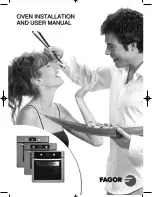
Grounding Instructions
This appliance must be grounded. In the event of an electrical short circuit, grounding reduces the risk of
electric shock by providing an escape wire for the electric current. This oven is equipped with a cord that
has a grounding wire with a grounding plug, which must be plugged into an outlet that is properly
installed and grounded. Consult a qualified electrician or serviceman if uncertain about the ability to
follow grounding instructions or if doubt exists as to whether the appliance is properly grounded.
X
DO NOT
use an extension cord. If the power cord is too short, have a qualified electrician or
serviceman install an outlet near the appliance.
WARNING: Improper grounding can result in risk of electric shock.
Power Cord Replacement
If the power cord is damaged, it must be replaced by the manufacturer, its service agent, or a similarly
qualified person.
Precautions to be Observed Before and During Servicing to Avoid Possible
Exposure to Excessive Microwave Energy
(a)
DO NOT
operate or allow the oven to be operated with the door open.
(b)
Make the following safety checks on all ovens to be serviced before activating the magnetron or other
microwave source, and make repairs as necessary: (1) interlock operation, (2) proper door closing,
(3) seal and sealing surfaces (arcing, wear, and other damage), (4) damage to or loosening of hinges
and latches, (5) evidence of dropping or abuse.
(c)
Before turning on microwave power for any service test or inspection within the microwave
generating compartments, check the magnetron, wave guide or transmission line, and cavity for
proper alignment, integrity, and connections.
(d)
Any defective or misadjusted components in the interlock, monitor, door seal, and microwave
generation and transmission systems shall be repaired, replaced, or adjusted by procedures described
in this manual before the oven is released to the owner.
(e)
A microwave leakage check to verify compliance with the Federal Performance Standard should be
performed on each oven prior to release to the owner.
Refer to page 22 for leakage test procedures.
RF Interference Considerations
The NGO oven generates radio frequency signals. This device has been tested and was determined to be
in compliance with applicable portions of FCC part 18 requirements and to the protection requirements
of Council Directive 89/336/EEC on the approximation of the laws of the Member States relating to elec-
tromagnetic compatibility at the time of manufacture. However, some equipment with sensitivity to sig-
nals below these limits may experience interference.
If your equipment experiences interference:
a
Increase the physical separation between this oven and the sensitive equipment.
a
If the sensitive device can be grounded, do so following accepted grounding practices.
a
If battery-powered microphones are being affected, ensure that the batteries are fully charged.
a
Keep sensitive equipment on separate electrical circuits if possible.
a
Route intercom wires, microphone wires, speaker cables, etc. away from the oven.
ii
SAFETY INSTRUCTIONS
Summary of Contents for SOTA NGO
Page 3: ......
Page 4: ...For further information call 800 90TURBO or 1 214 379 6000 ...
Page 12: ...Specifications and Installation ...
Page 13: ......
Page 18: ...Daily Maintenance ...
Page 19: ......
Page 22: ...Oven Controls and Cooking ...
Page 23: ......
Page 28: ...Info Test and Edit Mode ...
Page 29: ......
Page 38: ...Oven Systems ...
Page 39: ......
Page 52: ...Troubleshooting ...
Page 53: ......
Page 68: ...Oven Schematic ...
Page 69: ......
Page 71: ...46 This page intentionally left blank OVEN SCHEMATIC ...
Page 72: ...Appendix Replacing Oven Components ...
Page 73: ......












































